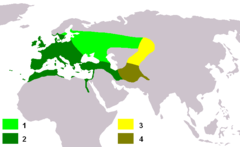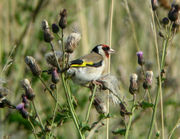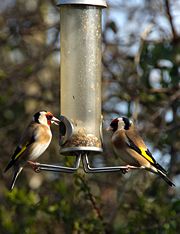European Goldfinch
2008/9 Schools Wikipedia Selection. Related subjects: Birds
| Goldfinch | ||||||||||||||
|---|---|---|---|---|---|---|---|---|---|---|---|---|---|---|
 |
||||||||||||||
| Conservation status | ||||||||||||||
|
Least Concern
|
||||||||||||||
| Scientific classification | ||||||||||||||
|
||||||||||||||
| Binomial name | ||||||||||||||
| Carduelis carduelis (Linnaeus, 1758) |
||||||||||||||
 Carduelis carduelis carduelis
1 summer 2 all year Carduelis carduelis caniceps 3 summer 4 all year |
The Goldfinch or European Goldfinch (Carduelis carduelis) is a small passerine bird in the finch family.
Range
It breeds across Europe, North Africa, and western and central Asia, in open, partially wooded lowlands. It is resident in the milder west of its range, but migrates from colder regions. It will also make local movements, even in the west, to escape bad weather. It has been introduced to many areas of the world (Snow and Perrins 1998).
Appearance
The average Goldfinch is 12-13 cm long with a wingspan of 21-25 cm and a weight of 14 to 19 grams. The sexes are broadly similar, with a red face, black and white head, warm brown upperparts, white underparts with buff flanks and breast patches, and black and yellow wings. On closer inspection male Goldfinches can often be distinguished by a larger, darker red mask that extends just behind the eye. In females, the red face does not reach the eye. The ivory-coloured bill is long and pointed, and the tail is forked. Goldfinches in breeding condition have a white bill, with a greyish or blackish mark at the tip for the rest of the year. Juveniles have a plain head and a greyer back but are unmistakable due to the yellow wing stripe. Birds in central Asia (caniceps group) have a plain grey head behind the red face, lacking the black and white head pattern of European and western Asian birds.
Taxonomy
The species is divided into two major groups, each comprising several races. The two groups intergrade at their boundary, so the caniceps group is not recognised as a distinct species despite its readily distinguishable plumage.
- Carduelis carduelis carduelis group.
- Carduelis carduelis balcanica. Southeastern Europe.
- Carduelis carduelis brevirostris. Crimea, north Caucasus.
- Carduelis carduelis britannica. British Isles.
- Carduelis carduelis carduelis. Most of European mainland, Scandinavia.
- Carduelis carduelis loudoni. South Caucasus, Iran.
- Carduelis carduelis major. Western Siberia.
- Carduelis carduelis niediecki. Southwest Asia, northeast Africa.
- Carduelis carduelis parva. Atlantic Islands, Iberia, northwest Africa.
- Carduelis carduelis tschusii. Corsica, Sardinia, Sicily.
- Carduelis carduelis caniceps group.
- Carduelis carduelis caniceps. Southern central Asia.
- Carduelis carduelis paropanisi. Afghanistan to western Himalaya and Tien Shan.
- Carduelis carduelis subulata. South-central Siberia.
Linnaeus classified the bird as Fringilla carduelis
Behaviour
The food is small seeds such as thistles (the Latin name is from carduus, thistle) and teasels, but insects are also taken when feeding young. It also regularly visits bird feeders in winter. They nest in the outer twigs of tall leafy trees, laying four to six eggs which hatch in 11-14 days.
In the winter they group together to form flocks of up to about 40 birds, occasionally more.
The song is a pleasant silvery twittering. The call is a melodic tickeLIT, and the song is a pleasant tinkling medley of trills and twitters, but always including the trisyllabic call phrase or a teLLIT-teLLIT-teLLIT.
In earlier times, the Goldfinch was kept as a cagebird for its song. Escapes from captivity and deliberate releases have colonised southeastern Australia and New Zealand.
As a garden bird
Goldfinches are attracted to back gardens in Europe and North America with specially designed birdfeeders containing niger (commercially described as nyjer seed). This seed of an annual from South Asia is small and black, and it seems, irrestible to goldfinches. It is high in oils. Small oval slits are introduced into a polycarbonate cylinder, and at these apertures, goldfinches feed while perching on small perches perpendicular to the vertical axis of the birfeeder.
Goldfinches in captivity
Goldfinches are commonly kept and bred in captivity around the world because of their distinctive appearance and pleasant song. The Goldfinch males are commonly crossed with Canary females with the intention to produce male mules with beautiful singing voices, that often capture the best singing attributes of both breeds.
European Goldfinches in religion
Because of the thistle seeds it eats, in Christian symbolism the goldfinch is associated with the Passion and Christ's Crown of Thorns. The goldfinch, appearing in pictures of the Madonna and the Christ Child, represents the foreknowledge Jesus and Mary had of the Crucifixion. In Barocci's Holy Family a goldfinch is held in the hand of John the Baptist who holds it high out of reach of an interested cat. In Cima da Conegliano's Madonna and Child, a goldfinch flutters in the hand of the Christ Child. It is also an emblem of endurance, fruitfulness, and persistence. Because it symbolizes the Passion, the goldfinch is considered a "saviour" bird and may be pictured with the common fly (which represents the sin and disease from which Christians believe Christ saved them). During medieval times, this bird was used by some as a charm to ward off the plague.

